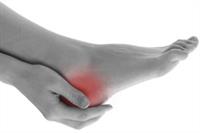
Do you experience severe pain in the heel and arch upon standing after periods of rest, for instance your first steps in the morning? Feelings of having a bruised heel? Does the pain often settle once you start moving only to return throughout the day? You may have plantar fasciitis!
What is plantar fasciitis?
Plantar fasciitis is one of the most common sporting injuries. And with the exception of trauma, it is the most frequent cause of chronic pain felt in the heel.
The plantar fascia is a strong connective tissue that attaches the heel to the ball of the foot and performs a vital supporting role in retaining the arch structure. As such, plantar fasciitis is when these ligaments that connect the heel to your toes become inflamed, causing heel and arch pain.
What causes plantar fasciitis?
Along with faulty biomechanics, the plantar fascia and heel bone can be overloaded by poorly constructed footwear, being overweight, or a change in activity levels.
Inflammation is only rarely observed and so the condition should probably just be called “plantar heel pain”, because “itis” denotes the presence of inflammation. In this regard, anti-inlammatory agents (eg. Ibuprofen) will not help the condition. The absolute key to treatment is to seek the earliest possible expert help!
Do’s and don’ts for plantar heel pain
DO…
- Seek expert opinion on this ASAP. The earlier the intervention, the better the outcome!
Consider taping of the plantar fascia in the short term.. This has proven benefits for pain and function - Consider an orthotic device, either custom made or generic, especially if the taping offers good pain relief.
- Stretch both the plantar fascia and the calves. Your sports medicine practitioner will teach you how. Be diligent!
- Recognise the importance of footwear, both athletic and non athletic. Get the right advice!
- Consider therapies like shock wave therapy if the heel pain has been present for more than 6 months and has resisted all other therapy.
- Maintain a healthy body weight
DO NOT…
- Run barefoot or in shoes with a low heel
- Schedule a steroid or other injectable treatments into the painful heel before exhausting conservative therapies above.
Our podiatrists will assess your postural, walking and running gait closely to determine why the damage has occurred, then prescribe an appropriate treatment plan to rectify the cause and relieve the symptoms.
Treatment plan for plantar fasciitis
Shockwave therapy is our newest and effective treatment used to treat the following conditions including heel pain:
- soft tissue pain
- tendon pain
- muscle pain
- athritis
- joint pain
- plantar fasciitis or heel pain
- Achilles tendonitis
Each appointment will take around 10 to 20 minutes and on average, six to eight treatment sessions are needed.
Shockwave therapy is performed in just a few simple steps:
- Your Footsmart podiatrist determines the issue needed to be addressed by looking for pain points in your legs and feet.
- They will then apply gel to the area, this helps the shockwave easily pass between the handpiece and your skin.
- Placing the shockwave handpiece onto the gelled area, radial shockwaves will pass into the affected tissue for the length of time necessary for your condition – this time does vary.
- Once the shockwave portion is finished, your podiatrist will then apply a muscle loosening treatment. This is to improve blood flow and relax trigger points in the muscles.
to learn more
